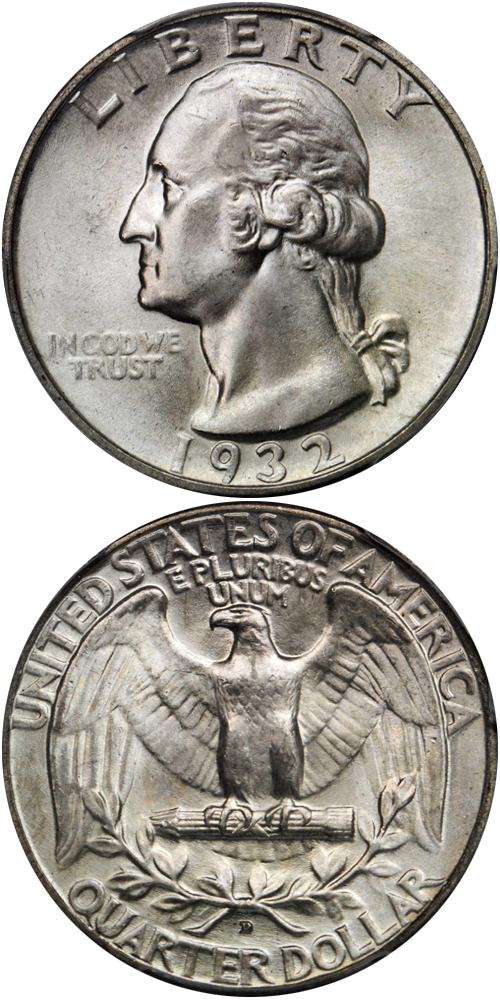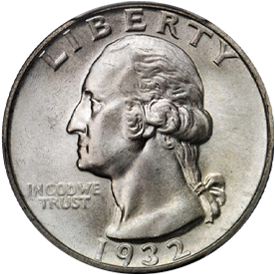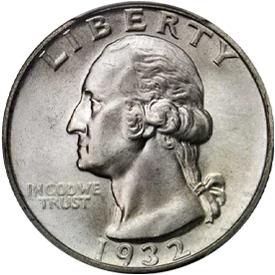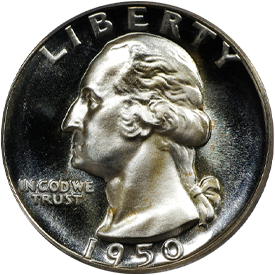Designed by: John Flanagan
Issue Dates: 1932-1964
Composition: 90% silver, 10% copper
Diameter: 24.3 mm
Weight: 6.25 grams (96.45 grains)
Edge: Reeded
Business Strike Mintage: 3,780,1177,001
Proof Mintage: 19,911,592
In observance of the 200th anniversary of George Washington's birth, the government decided to redesign the quarter dollar to depict the image of our first president. A lively competition ensued, and picked from this was a proposal of John Flanagan, a New York sculptor. The obverse of the Washington quarter dollar shows the head of Washington, modeled after a bust by Houdon, facing left, with LIBERTY above, IN GOD WE TRUST to the left, and the date below. The reverse shows a modernistic perched eagle, with a wreath below and E PLURIBUS UNUM above. UNITED STATES OF AMERICA and QUARTER DOLLAR inscriptions are at the borders. In silver alloy the type was minted continuously from 1932 to 1964, with the exception of 1933. After 1964, a new alloy was used.
The type set collector can readily obtain a later date in the series for low cost, in any desired condition from well-worn to superb Uncirculated. In addition, Proofs are available of the years 1936 through 1942 and 1950 through 1964.
Further Reading
No quarters were minted in 1931. In the following year, 1932, the 200th anniversary of George Washington's birth, the Washington quarter made its appearance. The required 25 years' use of a coinage design before a change had not elapsed with the Standing Liberty design, so an act of Congress, March 4, 1931, provided legislation for the new design. The work of John Flanagan, a New York sculptor, was chosen from approximately 100 entries. The portrait follows that of French sculptor Jean Antoine Houdon, whose bust of Washington is one of the best known.
Philadelphia Mint quarters of 1932 were saved in larger numbers due to the novelty of the design. Denver and San Francisco mint issues, produced in small quantities, were also saved, but apparently not to the proportional extent of the Philadelphia pieces. Today the 1932-D and 1932-S are the main scarcities in the series.
Scarce also is the 1934 (Philadelphia issue) with the motto IN GOD WE TRUST lightly defined (similar to all 1932 issues). However, the demand for the 1934 Light Motto variety is not great, so the issue does not sell for a significant premium. Even scarcer is the so-called 1934 Heavy Motto over Light Motto variety.
The 1936-D is rare only in Uncirculated condition, simply because at the time of issue few specimens were saved in original rolls. Apparently, collectors were more occupied with the commemorative half dollar craze then in full swing. Besides, the generous mintage of 5,374,000 1936-D quarters attracted little attention. It certainly was considered to be a "common'' quarter worthy of scant extra notice. By the time that Uncirculated pieces were found to be elusive, few remained. In worn grades, however, the 1936-D is very common, more so than the 1936-S (which has a lower mintage), so any assignment of a higher price for 1936-D in such grades as Fine, Very Fine, and Extremely Fine is patently absurd. However, one cannot fight city hall, or tradition, so worn pieces of 1936-D will probably continue to sell for more than worn pieces of 1936-S, simply because the respective Uncirculated coins show a differential.
Although they are not rare in an absolute sense, within the context of the Washington series there are a number of other pieces which are becoming hard to find, especially in Uncirculated preservation. Included are 1934-D, 1935-D, and 1937-S.
Curious and unexplainable, so far as the reason for issuing them is concerned, are the 1950-D over S and 1950-S over D over-mintmarks. Like so many die varieties which are not included in widely distributed popular coin albums, such pieces mainly appeal to the specialist. But there is no question that they are fascinating and numismatically significant.
Most Washington quarters are fairly well struck. There are, of course, exceptions. 1935-D, 1936-D, and 1937-D are sometimes weakly struck. Likewise, certain issues have more or less luster than others. Still, as of this writing there has not been a key feature, so far as striking is concerned, which has attracted numismatists. Thus, Washington quarters do not have the equivalent of full steps (Jefferson nickels), full split bands (Mercury dimes), and so on. Perhaps because there are not wide differences in striking, and perhaps because the series is a rather standard listing of dates and mintmarks, albeit with some scarcities.
In 1965, the composition of Washington quarters was switched from the 90% silver, 10% copper alloy to a “sandwich” composition made up of layers of copper-nickel (.750 copper, .250 nickel) bonded to a core of pure copper bringing to an end a nearly 170-year run of the use of silver in circulating coinage.









